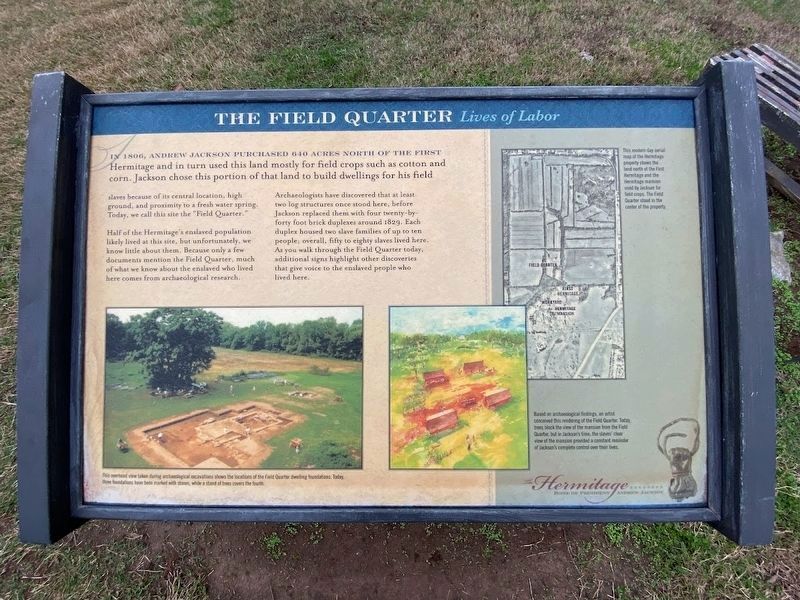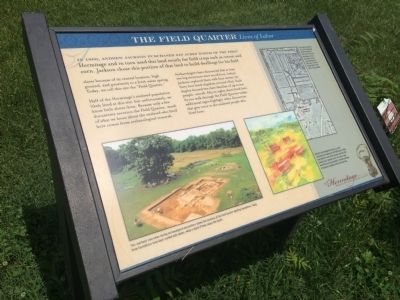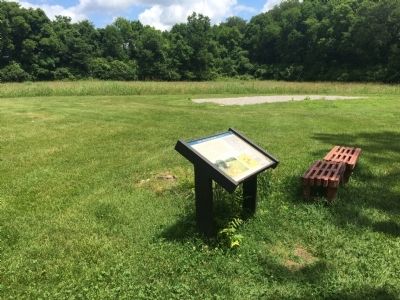Hermitage in Davidson County, Tennessee — The American South (East South Central)
The Field Quarter
Lives of Labor
Half of the Hermitage's enslaved population likely lived at this site, but unfortunately, we know little about them. Because only a few documents mention the Field Quarter, much of what we know about the enslaved who lived here comes from archaeological research.
Archaeologists have discovered that at least two log structures once stood here, before Jackson replaced them with four twenty-by-forty brick duplexes around 1829. Each duplex housed two slave families of up to ten people; overall, fifty to eighty slaves lived here. As you walk through the Field Quarter today, additional signs highlight other discoveries that give voice to the enslaved people who lived here.
Captions:
This modern day aerial map of the Hermitage property shows the land north of the First Hermitage and the Hermitage mansion used by Jackson for field crops. The Field Quarter stood in the center of the property.
Based on archaeological findings, an artist conceived this rendering of the Field Quarter. Today, trees block the view of the mansion from the Field Quarter, but in Jackson's time, the slaves' clear view of the mansion provided a constant reminder of Jackson's complete control over their lives.
This overhead view taken during archaeological excavations shows the locations of the Field Quarter dwelling foundations. Today, three foundations have been marked with stones, while a stand of trees covers the fourth.
Erected by The Hermitage Foundation.
Topics. This historical marker is listed in these topic lists: African Americans • Agriculture • Anthropology & Archaeology. A significant historical year for this entry is 1806.
Location. 36° 13.214′ N, 86° 36.704′ W. Marker is in Hermitage, Tennessee, in Davidson County. Marker is on Field Quarter Trail, on the left when traveling east. The marker is on the Field Quarter Trail at The Hermitage. Touch for map. Marker is in this post office area: Hermitage TN 37076, United States of America. Touch for directions.
Other nearby markers. At least 8 other markers are within walking distance of this marker. A Lively Place (a few steps from this marker); "Have the Negro Houses Placed Where the Old Ones Stands" (a few steps from this marker); Stories Told by Things the Enslaved Left Behind (a few steps from this marker); The Field Quarter Spring (about 300 feet away, measured in a direct line); Land Conservation at The Hermitage (about 400 feet away); Determined Resistance (about 600 feet away); The Hermitage Overseer (approx. 0.2 miles away); Ginning and Pressing "King Cotton" (approx. 0.2 miles away). Touch for a list and map of all markers in Hermitage.
Credits. This page was last revised on February 7, 2023. It was originally submitted on July 13, 2015, by J. Makali Bruton of Accra, Ghana. This page has been viewed 313 times since then and 9 times this year. Photos: 1. submitted on January 23, 2023, by Darren Jefferson Clay of Duluth, Georgia. 2, 3. submitted on July 13, 2015, by J. Makali Bruton of Accra, Ghana. • Andrew Ruppenstein was the editor who published this page.


